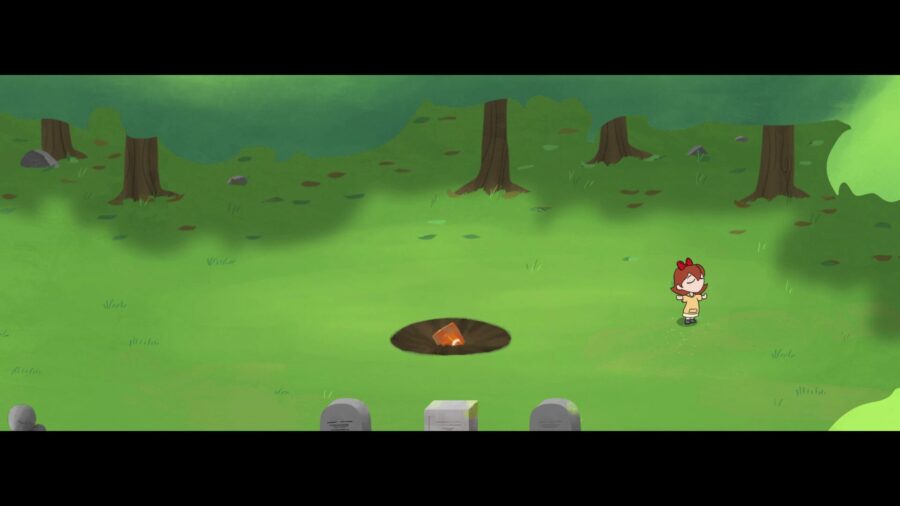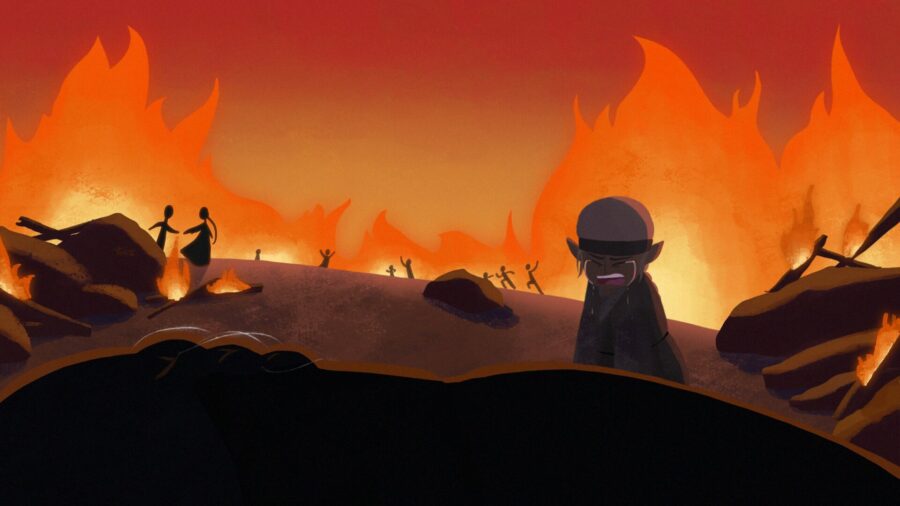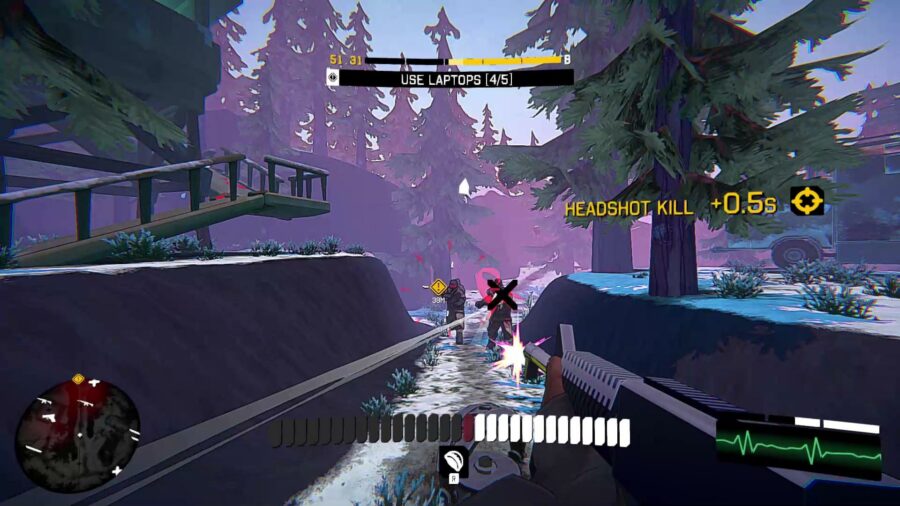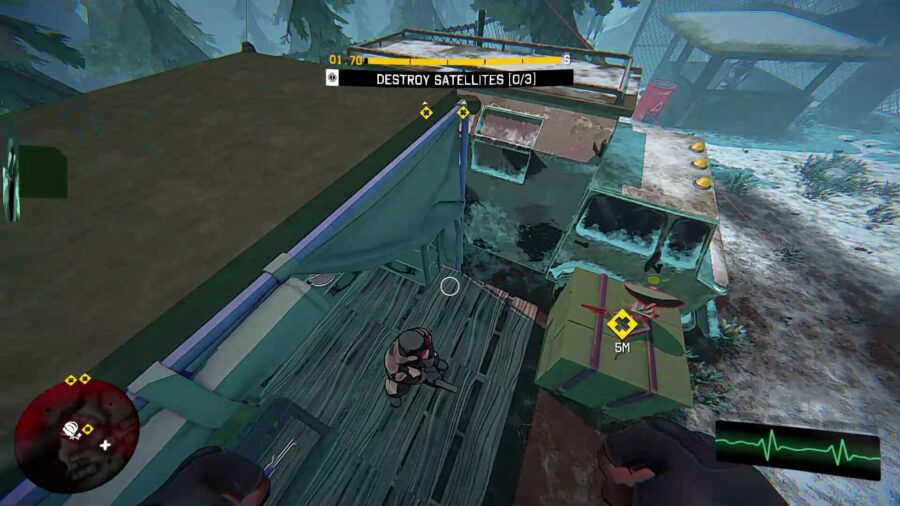Cricket: Jae’s Really Peculiar Game is a pretty familiar JRPG – they put it right there in the subtitle, after all – with particular influence from the RPGs of the Super Nintendo’s catalog. For its combat, the most direct point of comparison is something like the various Mario role-playing game series. Character statistics, equipment options, and available actions in combat are all relatively uncomplicated. Combat is supplemented by opportunities to increase damage dealt or reduce damage taken with timed inputs, similar to the Action Commands in Paper Mario, Mario and Luigi, or Super Mario RPG.
And for the record, they’re called Action Commands in the SMRPG remaster. You can’t touch me, oldheads.
Cricket is also the story of a group of kids with complicated parental relationships trying to travel to the moon to be granted wishes. Jae, his best friend Zack, the mysterious-yet-bubbly Symphony and a party of new friends they meet along the way are trying to reach a place on the moon called Yimmelia, where wishes are granted. Along the way, they’ll fight shark gangsters, take over for an indisposed singer, attend a fan convention, and witness grim episodes of ancient history through a series of mysterious magical fires. It can be a bit much.
Generally, the difficulty level is not terribly high. I assume that this is intended at least in part to maintain accessibility for children, and I can’t fault the developers for not trying too hard to satisfy the weird obsessive RPG nerd in me. There is also a button marked Win in the combat menu, which does in fact make you win the fight. This is a great way to give the player control over their experience of the game, but I can’t say it reflects positively on my experience with the game’s combat that I found myself habitually skipping encounters.
In its overall atmosphere, tone, and presentation, Cricket draws heavily on the comedic elements common to many games in the genre. In particular, with its party of young children fighting with things other than weapons, assortment of weird enemies, and main plot kicked off by a character crashing to earth outside a small town and delivering a somewhat mysterious call to adventure to our heroes, Cricket wears its love for Earthbound on its sleeve.

Symphony (pictured immediately following her own crash landing) does fare better than Buzz Buzz in the longer run, though.
A brief aside: as someone five years younger than Earthbound, I have to say that the combination of elements reminds me of nothing so much as the MARDEK series of Flash games. Admittedly, I make this particular reference not so much to help the average person reading this review understand me as in the hopes of making a handful of readers go absolutely wild that someone mentioned MARDEK.
Like many games with comedic elements, Cricket does not devote itself entirely to laughs, but seeks to balance its humor with a more serious story. All of the main party’s characters have problems in their relationships with their parents, which act as major defining elements for their characters. Jae’s mother is recently deceased and he hopes to use his wish to return her to life, Charlie is affected by their parents’ absurdly high expectations, and Zack wants to challenge his absent father to a boxing match to prove his own worth. I found all of these relationships compelling. They make for great motivations, and the character writing surrounding them is consistently excellent.
In a thread that plays out mostly in parallel to the others, the party occasionally comes across strange white flames. If anyone other than Jae touches these, they just get burned, but when Jae touches them he experiences visions of unknown people in various scenes – some tragic, some nostalgic, and some desperate and terrifying.

Naturally, the paths of the story gradually converge, but the white flame story spends quite a lot of time on the sidelines, playing out in tantalizingly small moments interspersed through the game.
Ultimately, for most of the time that I spent on Cricket’s gameplay and more comedic writing elements, I just wanted to get back to the serious parts. On one hand, I like to think that reflects more positively on the quality of the dramatic writing than it does negatively on the other elements. On the other hand, it still makes for a frustrating experience.
I like Cricket well enough, but I certainly don’t love it. If you like the comedy or the combat more than I do, you’ll probably find the game suits you better. And if anyone involved in writing for the game has done anything a little more focused on the dramatic, I would be thrilled to give that a try. – Bex Kane
[Cricket: Jae’s Really Peculiar Game, developed by Studio Kumiho and published by PM Studios, is now available for $24.99 for PlayStation 4&5, Xbox Series X|S, Nintendo Switch, Steam, and the Epic Games Store. This review was written using a Steam review code sent to Hard Drive by Cricket’s PR representative.]
——–

Meanwhile, on the other end of the emotional spectrum, I’ve been killing a lot of people in I Am Your Beast.
I needed something fast and snacky, and that’s IAYB: a parkour FPS where every stage is only a couple of minutes long. It’s an elaborate carnival of bespoke violence that rewards you for creative kills, quick decisions, and never slowing down.
You play IAYB as Alphonse Harding, a government assassin who retired to a quiet life in an unnamed forest. When his former commanding officer Burkin sends a couple of goons to retrieve Harding for what would be his sixth “one last job,” Harding has a moment of weakness and kills them both. Burkin does not accept that as an answer, and the situation rapidly degenerates into an all-out war between Harding and his former agency.
When you write out its premise like that, it makes IAYB sound like it’s an intense, desperate stealth game in the spirit of Metal Gear Solid. It isn’t. Harding vs. an actual army is an even fight, as Harding is a superhuman monster who can punch heads off, ignore multi-story falls, and run at full speed across telephone lines. I kept expecting a story beat about how Burkin wanted his nanomachines back, but one did not materialize; Harding’s apparently just cool like that.
As a result, IAYB could be usefully described as Tom Clancy’s Friday the 13th. Every stage opens with you emerging from hiding to lay waste to another squad of hapless soldiers with whatever you can get your hands on. If you die, it’s more likely that you screwed up than that the soldiers were actually able to kill you.

Your goal is always to accomplish your objectives and escape in as little time as possible, but every soldier you drop along the way gives you a bonus to your final score. This is less about figuring out the most efficient intended path through each level and more about your personal execution, as there’s always room for creativity along the way.
It’s hard to convey how fluidly IAYB moves with still shots; it’s worth watching its trailer to see it in action. Its graphics are relatively simple; every soldier is the same anonymous goon in cold-weather gear, and every piece of dialogue is plain text against a still image. That’s all in service of emphasizing the raw speed at the heart of the experience. IAYB has been stripped down to its barest elements, in a way that’s vaguely reminiscent of Harding himself. It’s simple, but it works.

I do want to draw a straight line between this and last year’s El Paso, Elsewhere. Both it and IAYB were written by Xalavier Nelson Jr., who also voices both games’ protagonists, and he’s given them both the same sense of humor. Both Harding and James Savage are so anesthetized – Harding by his experiences, Savage by actual drugs – that the best reaction they can muster to anything is usually a little ultra-dry quip. I still got a chuckle out of a couple of moments in IAYB, but after clearing El Paso, I had a distinct sensation of deja vu.
In more germane commentary, it’d be nice if IAYB was a little more precise. It feels like the developers added in some generous auto-aim to compensate for fiddly physics, as every once in a while, I found myself scoring clean headshots against distant targets with no effort whatsoever.
That didn’t translate to some of the movement mechanics, especially Harding’s stomp, where you can take out a grounded target by landing on their head. There are a couple of stages where your only initial move is to jump off a ledge onto some unsuspecting soldier, and it’s too easy to overshoot them for no particular reason.
It also has a weird gimmick where several stages are gated behind your level rank, so you’ll occasionally have to replay older stages in order to unlock later story missions. It’s not a bad way to train the player to handle some of the tougher challenges in the endgame, but it does create a dissonance between the narrative and the gameplay. In an experience that’s mostly about momentum, IAYB forces you to shift into reverse several times, and it’s never not jarring.
Even so, a blind run through the story campaign takes about 6 hours, if that, and IAYB has the good sense to end before it runs out of ideas. If you’re in the mood to play something that’s fast, accessible, and doesn’t burn an hour on setup before it gets to the good parts, I Am Your Beast has you covered. – Thomas Wilde
[I Am Your Beast, developed by Frosty Pop and published by Strange Scaffold, is now available for $19.99 on Steam. This review was written using a Steam code purchased by Hard Drive.]




